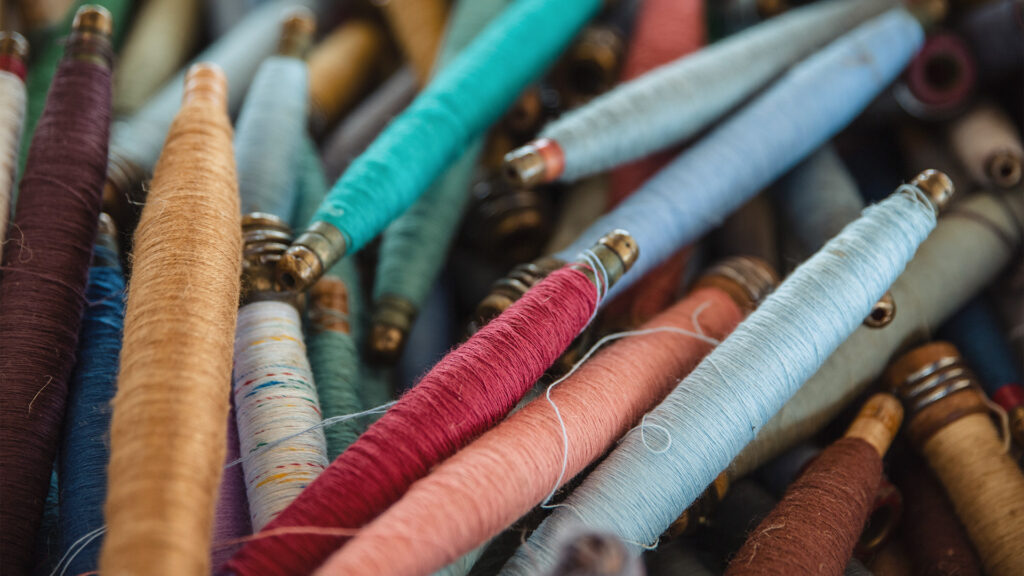Today, according to McKinsey & Co., more than 15 kilos of textile waste per person are generated in Europe alone, most of which ends up in landfills or incinerated in countries of the Global South. One solution to this problem is recycling fibers to turn waste into new fabric.
Natural Fibers vs. Recycled fibers
According to the Ellen MacArthur Foundation, 97% of all materials used to produce garments come from virgin raw materials, while of the remaining 3% from recycled materials, only 1% is recycled textiles.
To make the distinction, natural fibers are natural fabrics 1) of vegetable origin such as cotton, linen, hemp, or cellulose such as rayon or viscose; and 2) of animal origin such as wool, silk, and leather.
Compared to synthetic fibers, they have the sustainable advantage, of a lower environmental footprint since they require fewer chemicals and energy use in their production and are naturally biodegradable.
On the other hand, the ISO 14021 standard defines recycled materials as processed from materials recovered through a manufacturing process and converted into a final product or component for incorporation into a product.
The sustainable advantage of recycled fibers is that they reduce waste and the use of arable land and new materials.

Impact
However, biodegradability is not the only thing to consider for a fabric to be sustainable. The negative impact of the fashion industry on biodiversity is a consequence of the production of natural fibers.
The sourcing of cellulosic fabrics to make viscose contributes negatively to global deforestation. NGO Canopy estimates that more than 300 million trees are cut down for this purpose each year.
In addition, animal tissues from livestock farming require a greater consumption of land resources.
The fashion industry will use 35% more land for fiber production by 2030.
Fashion Revolution
The use of recycled materials not only reduces the use of virgin materials but also saves water and energy, reducing the use of natural resources necessary to produce new garments.
Currently, it is estimated that less than 1% of the world’s textile waste is recycled into new garments.
According to the European Commission, less than a quarter of Europe’s 5.2M tonnes of garment waste is recycled while millions of tonnes end up in landfills every year.
Therefore, under its new legislation, Europe not only obliges Member States to separate textiles from other waste from January 2025, but also that garments must be durable and recyclable, and made from recycled fibers by 2030.

Turning into value
Cotton
Its cultivation consumes large amounts of water and insecticides.
In particular, jeans are one of the most polluting garments in the textile sector. It is estimated that around 7,000 liters of water and chemicals are used in its production.
Fortunately, recycled cotton massively reduces the amount of water, energy, and dye used. While denim is one of the most advanced fabrics in the field of fiber recovery:
- The Blue Jeans Go Green™ program collects cotton denim to recycle and return it to its original fiber state, transforming it into something new.
- MUD Jeans is a B Corps that puts the principles of the circular economy into practice, allowing you to rent jeans for a small monthly fee and, after a year, return them, exchange them for new ones, or keep them. And at the end of their useful life, they recycle them into new ones.
Cellulose
Renewcell’s technology dissolves cellulose fibers such as cotton from discarded garments and transforms them into Circulose® pulp, preventing textiles from becoming waste and reducing the demand for virgin raw materials. Brands such as Levis, GANNI, Filippa K, PVH, H&M, and Inditex have used this technology.
TENCEL™ Lyocell fibers are produced with the innovative REFIBRA™ technology that allows cotton scraps to be recycled as well as wood pulp (sourced entirely from certified and controlled sources) during the closed-loop production process, meaning that water and solvents are reused every time.
Likewise, Infinna™ is a textile fiber created from cotton-rich textile waste that is no longer suitable for use. This technology has been used by firms such as Patagonia, Ganni, Adidas, PVH, Inditex, and H&M Group.
Wool
Wool is another of the most appreciated natural fibers for its high quality and durability.
However, according to Good on You, this fabric has a very high impact on the environment: the production of a wool knitted sweater emits 27 times more greenhouse gases than a cotton one.
In addition, cropland used to feed animals accounts for almost 80 percent of the total agricultural area. While intensive sheep farming also leads to soil degradation and even desertification.
Fortunately, recycled wool not only retains its thermal properties but also reduces the environmental impact associated with its production by eliminating carbon emissions linked to animal husbandry.
The production of new alternative and innovative materials shows how circular textiles can contribute to a more sustainable future.
In search of circularity
Synthetic fabrics from fossil fuels such as polyester, nylon, acrylic, and elastane, generate a great harmful impact on the environment throughout their useful life.
The Global Fashion Agenda indicates that 35% of pollution in the oceans comes from synthetic fibers: with each wash, these fibers release hundreds of thousands of plastic microfibers into the environment.
On the other hand, the manufacture of this type of fiber releases methane and carbon dioxide into the atmosphere, contributing to global warming, being a type of plastic, it is not biodegradable and takes many years to decompose.
Polyester
This fiber is the most widely used in the fashion industry and accounts for half of the total fiber market.
Currently, an alternative to this material is recycled polyester, which is estimated to be 99% of recycled PET plastic bottles, which, when collected and sorted, are washed, and melted, turning them into fibers.
Launched in 2007, REPREVE® is the global leader in high-performance recycled fibers that has transformed billions of recycled plastic bottles into sustainable polyester.
Nylon
It is a synthetic fiber that is frequently found in garments.
To create recycled nylon, REPREVE® uses nylon scraps, which saves energy and resources. In addition, it meets the rigorous criteria of OEKO-TEX® STANDARD 100, which guarantees that a textile item has been tested for harmful chemicals and that it has been sustainably manufactured under environmentally and worker-friendly working conditions.
ECONYL® was created by the Italian company Aquafil, which specializes in the production of recycled nylon and is made entirely from recycled nylon waste found in oceans and landfills. For every 10,000 tonnes of ECONYL®, 70,000 barrels of oil are saved, and 65,100 tons of CO2 emissions are avoided, reducing the impact of nylon on global warming by up to 90% compared to material from petroleum.

The future is circular
Large-scale recycling of blended textiles is a step in the right direction towards a circular fashion industry.
However, the lack of infrastructure to recycle fibers into textiles with a combination of natural and synthetic is a challenge due to the complication involved in separating the two types of fibers.
As estimated by the consulting firm McKinsey in its report, between 6,000 and 7,000 million euros of investment will be needed between now and 2030 to create the scale of processing and recycling of textile waste to which the European Union aspires.
In other words, if fiber-to-fiber recycling were prioritized at scale, the sustainable development goals could be met on time.





